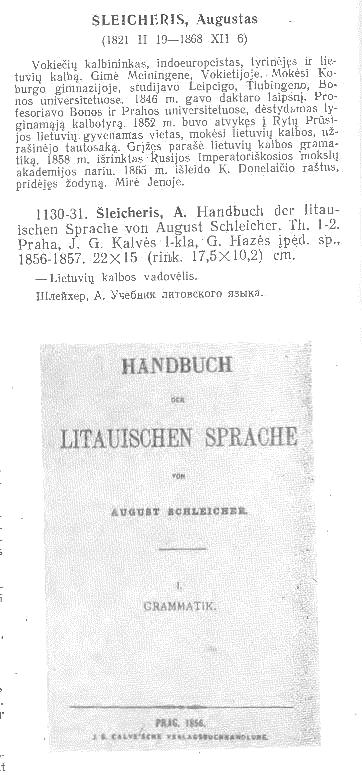Bibliography of Bibliographies
There are a few thorough descriptions of the bibliographic history of Lithuania but bibliographies of bibliographies are not as common there as they are for Poland or Russia. The interested scholar should consult either or both of the following works for the history of bibliography in Lithuania: Zukas, V. Lietuviu Bibliografijos Istorija. I. Vilnius: “Mokslas” 1983 (U of I Library call number Main Stacks 010.9475z84l) and Birziska, V. Lietuviskos bibliografijos istorija. Kaunas, 1944 (Not held at U of I). Birziska’s 32-page work appears to only be available in Lithuania and a few of the German collections (this according to WorldCat). It was part of a series entitled “Bibliotekininko parankine.” Zukas’ and Birziska’s books are cited as the standards on the history of bibliography for the region. Zukas’ book is the more extensive of the two with a detailed discussion of how bibliographic publications developed and the bibliographic sources for various disciplines. It does not include a separate bibliography of sources but is heavily annotated. Another good source for background information is Semenovker’s Retrospektivnaia Gosudarstvennaia Bibliografiia SSSR: Spravochnik. Moskva: Izdatel’stvo “Knizhnaia palata.” 1990 (U of I Library call number 016.01547 SE52R available in International & Area Studies–Russian reference and in the Main Stacks). For anyone seeking the history of the national bibliography for the regions dominated by the Soviet Union this is an excellent guide. The volume begins with an extensive discussion of bibliography in the USSR as a whole. The second section is divided by region. Those pages devoted to Lithuania begin with the period of Soviet domination in 1940 and the establishment of the Lithuanian Book Chamber. The organization and publication of all the sub-series of the Lithuanian national bibliography are described in some detail. Obviously, this is all done with the bias of the Soviet period clearly in play. Nevertheless, it does provide the scholar with a framework for identifying the national bibliographic publications of the latter part of the twentieth century.
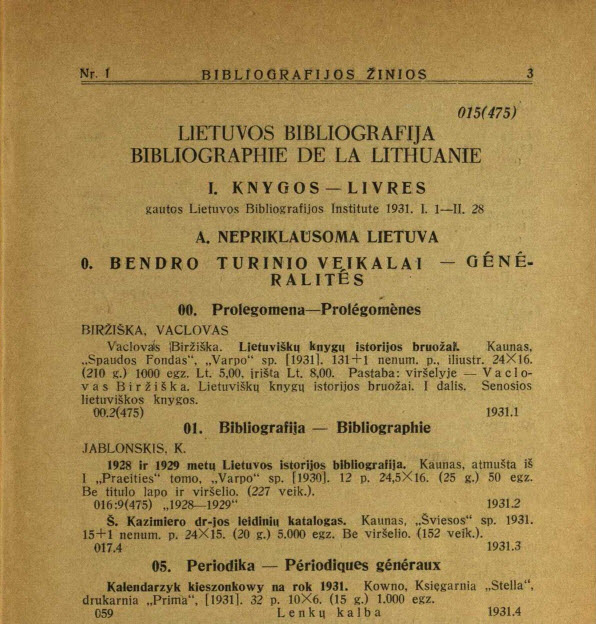
Bibliografijos Žinios. Kaunas: “Spaudos fondo” knygynas. 1928-1943.
http://www.epaveldas.lt/vbspi/biSerial.do?biRecordId=2368
This was a serially published list of the titles issued in independent Lithuania between 1928 to 1943. This bi-monthly publication contained a listing of the bibliographic publications issued in Lithuania along with articles on publishing in general. The full-text of the issues are available in PDF format at the URL listed above. Images are easy to browse with consecutive pages displayed at the top or numbers below for navigation. Bibliografijos žinios went through several manifestations over time- other examples will be described throughout this guide.
Bibliografijos žinios and other sources are made available through a collaborative effort among different organizations. The project of collecting and making accessible the cultural heritage of Lithuania to the whole world was funded by the European Union Structural Funds; the National Library of Lithuania received 12.4 million LTL for the project. The databank now contains over 3 million pages of valuable old books, newspapers, artwork, manuscripts and church registers. Currently, ten institutions are participating in this project, including the Martynas Mažvydas National Library of Lithuania, Vilnius University Library and the Lithuanian Art Museum. The virtual library system is open and free and so ensures equal opportunity for all users. For more information about this project, see h ttp://www.epaveldas.lt/vbspi/content/about.jsp
Lietuvos TSR Bibliografines Priemones. 1971-1989. Vilnius Lietuvos Nacionaline Martyno Mazvydo Biblioteka
Lietuvos Bibliografines Priemones. 1990-2006. Vilnius: Lietuvos Nacionaline Martyno Mazvydo Biblioteka
U of I Library Call Number: International & Area Studies–Baltic Reference Q.015.4793 L625 (1999-2001)
This annual publication lists “bibliographic tools of all types” issued in Lithuania- literature indices, lists, surveys, catalogs, memoranda for readers, etc. Even somewhat obscure bibliographic sources such as bibliographies found in dissertations and textbooks are included. Journal indices are also listed here. The bibliography is arranged by subject, which are ordered according to the University Decimal Organizational system. Included in each fascicle is an index of compilers and personal names. The titles listed here are extracted from the other series of the national bibliography. The publication ceased in 2006, meaning the last year of records is from 2005.
National Bibliography – Print Resources
Knygos Lietuviu Kalba/Bibliografiia Litovskoi SSR. Ser. A. Knigi na litovskom iazyke. Vilnius: Leidykla “Mintis.” 1969-1988
U of I Library Call Number: International & Area Studies–Baltic reference 015.475 L625
T. 1. 1547-1861
T. 2: Pts. 1-2. 1862-1904
Bibliographic information for the earliest Lithuanian works can be tracked in this bibliography. While there is no true national bibliography for this early period, this work makes the attempt to track the early intellectual history of the published Lithuanian language. The majority of the titles cited in the bibliography were examined de visu. In those cases where this was not possible the source of the information on the work is included in the citation.
The bibliography was compiled under the direction of the Lithuanian Book Chamber. Materials for the entries were drawn from all the major collections in Lithuania, Russia, Poland and other foreign collections with significant holdings of Lithuanian materials. The intent was to create the most complete record possible of Lithuanian language publications issued from 1547 to 1904.
The bibliography is arranged in simple alphabetic order by main entry, usually by the author. Those works without a named author are entered by title. The entries themselves are quite elaborate in many instances. Many include biographical information on the authors, references to reviews, references to early bibliographic citations to the works, and reproductions of title pages.
The three volume set has a number of valuable supplements including an extensive collection of Lithuanian publishing statistics. There is also a list of books that were published in languages other than Lithuanian but included Lithuanian texts and a list of manuscript materials. There are extensive and detailed indexes including a chronological index, name index, index of titles, an index of typographers, an index of sources consulted, and an index to biographies cited in the text. Volume 2, part two has an index of series entries, index of collective authors, and a geographical index.
A section of rich illustrations is appended to each of the volumes as well.
Lietuvos bibliografija Serija A. Knygos lietuvių kalba (The Lithuanian bibliography. A series of books in Lithuanian). 1905-1917, CN. 3; Lietuvos bibliografija (The Lithuanian bibliography. A series of books in Lithuanian). Wed 3rd 1905-1917, CN. 1-2.; Knygos lietuvių kalba, 1918–1940: kontrolinis sąra (Books in Lithuanian, 1918-1940: a checklist). T. 1 SAS. 1-8, T. 2, sąs.1-2;
U of I Library holds only two uncatalogued volumes of this set so far.
The contents of this bibliography are included in the Lithuanian National Library online catalog. This is an excellent example of how each format, print and digital, have their advantages. An author search can produce very different results in one of the print and online versions.
Example: Search for the author Morisas Leblanas. In the print version this search returns 5 items. In the online catalog the author search returns over 40 matches. These include the 5 listed in the print source but also have Polish and French translations of the author’s works published during these years and many later publications.
If the user’s intent is just to identify Lithuanian language publications issued between 1918 and 1940, before Soviet control was imposed, the print source will be most efficient. If, however, a user were seeking everything by and about a particular author who was active during these years, the digital catalog might be a better resource, providing the most comprehensive search.
The user should also be aware that the entries online are not always searchable in the same way as they are in the print bibliography. So, for example, while you can search for an author and find some entries under his/her name, you may find more entries for his/her works with a broader search, such as a keyword search that includes the author’s name. Such a search will yield results that include records in which the author’s name appears in a notes field only. You will also find later works and works in foreign languages in the online catalog which would not be listed in the print catalog.
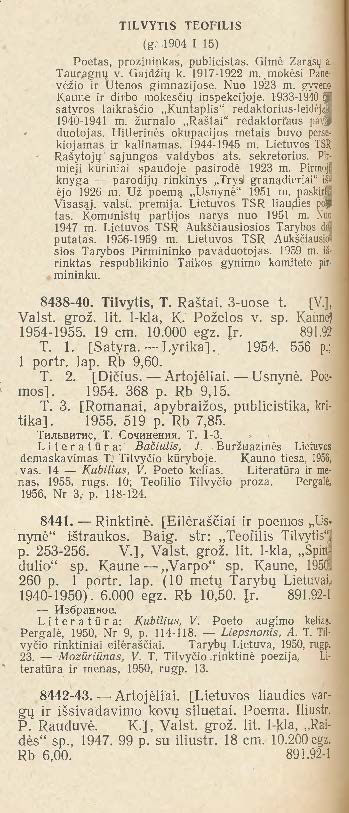
Lietuvos TSR Spauda. Valstybine Suvestine Bibliografija/Pechat Litovskoi SSR: Gosudarstvennaia Svodnaia Bibliografiia . Vilnius: Valstybine Politines ir Mokslines Literaturos Leidykla, 1962-1982.
T. 1. 1940-1955: in 2 books Book 1-books and brochures; Book 2-periodicals, avtoreferaty, music, art and maps
T. 2 1956-1965: in 2 books. Book 1-books and brochures; Book 2-periodicals, avtoreferaty, music, art and maps
U of I Library Call number: International & Area Studies–Baltic Reference 015.475 L6252
This is an excellent bibliography where the entries include more than just the bibliographic information describing each item. It includes references to review articles, biographical citations and a brief biographical overview for many authors. This will help the uninitiated researcher begin their exploration of a topic by listing the major sources on an author and his writing. So, for example, the entry on Teofilis Tilvytis in volume 1, book 1 of the 1940-55 section of the bibliography provides a brief description of the poet, his life and important facts. The entry also includes listings of major sources to consult.
Spaudos metraštis/Lietuvos TSR Knygų rūmai = Letopisʹ pechati/Knizhnai︠a︡ palata Litovskoi SSR. Vilnius: Valstybinė politinės ir mokslinės literatūros leidykla, -1992.
U of I Library Call Number: Main Stacks 015.475 Sp28 [1962-63, 65-67, 69, 78-87]
Online
Split into:
Bibliografijos žinios: Knygos
Bibliografijos žinios: Serialniai leidinai.
Bibliografijos žinios. Lituanika.
Bibliografijos žinios. Garso ir vaizdo irasiai, elektroniniai istekliai.
For later volumes see:
- International & Area Studies–Baltic Reference Q.015.4793B471 2008-2012
- Main Stacks Q.015.4793B471 1996-2007, incomplete
- International & Area Studies–Baltic Reference Q.015.4793B4712 1996-2007, incomplete
- Oak Street Facility Q.015.4793B4713
- International & Area Studies–Baltic Reference Q.015.4793B4714 1995, 1998-2002, 2009
- Main Stacks Q.015.475Sp281a 1996-2001, 2003
This is the national bibliography for Lithuania. It is modeled on the Soviet national bibliography to some extent. Like the Soviet bibliography, the Lithuanian national bibliography has been divided into four subseries: books (Knygos), serial publications (Serialniai leidinai), publications about Lithuania published outside the country (Lituanika) and sound recordings, video recordings and electronic media (Garso ir vaizdo irasai, elektroniniai istekliai).
The entries in this bibliography, available in full text online, are far simpler than those included in the compiled retrospective volumes described above. Full bibliographic information is provided with subject organization based on the universal Dewey system. But the biographical entries and review citations found in the earlier volumes are not included here.

Ekspresinformacija apie naujus spaudinius, išejusius lietuvoje
U of I Library Call Number: 015.4793 EK78 (current issues available in the IAS library, Slavic Periodicals section)
A good source for bibliographic information on current publications is the Ekspresinformacija apie naujus spaudinius, išejusius lietuvoje. It is published once or twice a week and available in print and electronically. Issues from 2004 to the present are linked through this page. The print version of the publication comes in a leaflet format.
The publications are organized by subject; the bibliography includes publications in languages other than Lithuanian, including English and Russian. Ekspresinformacija is published by the Center for Bibliography and Book Science at the Lithuanian National Library; the Center succeeds the Lithuanian Book Chamber. This source lists books and articles published and cataloged that week by the Center.
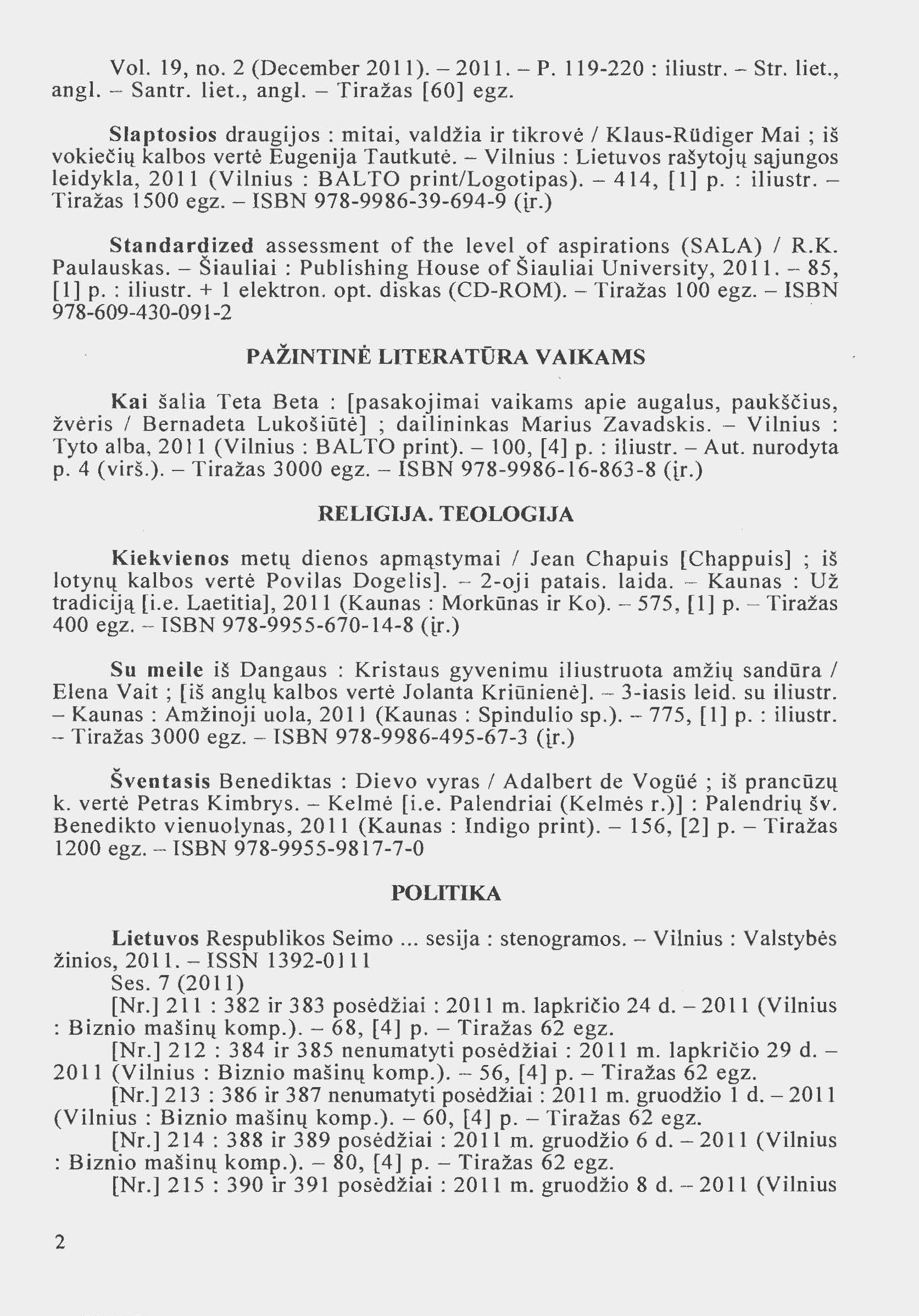
Online Resources
Nacionalinės bibliografijos duomenų bankas: National Bibliographic Data Bank
Description of the contents of the National Bibliographic Database available via http://nbdb.libis.lt/
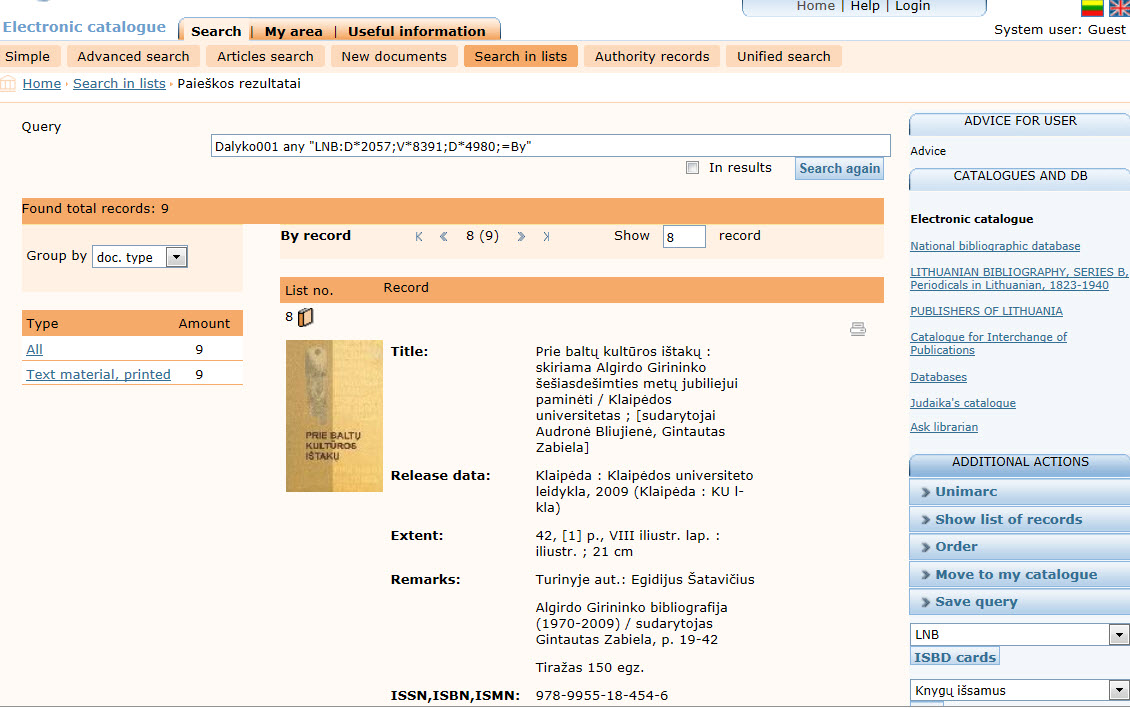
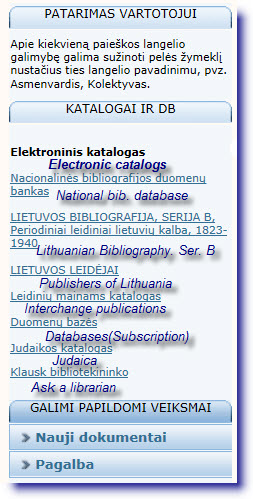 Development of the national bibliographic database (NBDB) began in 1998. Since then the database has amassed over 1,844,154 bibliographic records (as reported 2011, 1 January). This was accomplished partly as a result of a depository law that required a copy of every book, pamphlet, sheet music, artistic production or reproduction, map, serial publication, audio or video recording, electronic resource and Braille publication be deposited in the National Library.
Development of the national bibliographic database (NBDB) began in 1998. Since then the database has amassed over 1,844,154 bibliographic records (as reported 2011, 1 January). This was accomplished partly as a result of a depository law that required a copy of every book, pamphlet, sheet music, artistic production or reproduction, map, serial publication, audio or video recording, electronic resource and Braille publication be deposited in the National Library.
The library was also responsible for collecting and recording in the national bibliographic database all obtainable publications about Lithuania (Lituanika) and incorporating retrospective records for publications issued from 1547-1917 and small print run titles issued between 1918 and 1940.
These publications are listed in a separate databases, accessible from the sidebar of the catalog page. (see image at left)
Records of Yiddish publications collected in the library since the beginning of the 19 th century are also available in a separate database accessible via the menu on the main catalog page.
This library has an extensive collection of Russian and Polish language materials that should not be overlooked.
Retrospective national bibliography in image format is available at:
http://vaizdai.libis.lt/?lang=en
This is a complex set of files that does require some patience, but for those seeking a comprehensive literature search and who lack access to a library with the full array of publications needed for such a search, this set of databases will definitely fill the gap. Russian, Lithuanian and German publications are all listed here. There is a straight card file in main entry order as well as an authority file with works arranged by author.
All the national bibliography components beginning with the retrospective bibliography Knygos Lietuviu Kalba that covers 1547-1904 and continuing with the true national bibliography from 1940-1993 are available at this site. All the contents have been digitized and are available here including the index materials. It can be a bit trying to use but if you are without any other access this can be a very useful source.
This same link provides access to the scanned card catalog of Russian language publications held at the national library, other foreign language materials held there, the collection of sheet music, records and CDs.
Overview of retrospective print resources for national bibliography:
The national retrospective bibliography in 1547-1940 includes publications (books, periodicals, publications, periodicals and printed publications) in the Lithuanian language, regardless of their place of publication. These sources have been digitized but are not searchable in these versions. The bibliography also lists publications issued on Lithuanian territory in other languages: Latin, Polish, Yiddish and Hebrew. Knygotyrinį perform work up a data base. The retrospective bibliography is part of the retro-conversion project started in 1999 and the project’s ultimate purpose is to create a complete computer catalog of the library’s holdings. The project was sponsored by the Lithuanian government along with the Open Society Institute of Budapest. Although it is difficult to use, the collection of records is impressive and could be incredibly helpful for the user. In terms of the card catalog files, the website provides some guides in how to search for documents which may prove incredibly useful.
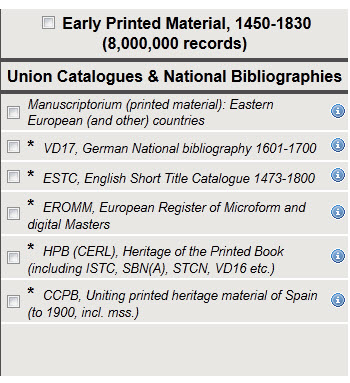
Hand Press Books Database
The single European Hand Press Books Database (http://www.cerl.org/web/) is a collection of participating libraries and organizations who have digitized some of their oldest materials, from the start of printing through 1830. The Database includes computerized bibliographic records of the sources.
In terms of Lithuania, the HPB database includes around “2,000 records covering 18th-century Polish books issued in Lithuania, Hebrew books issued in Lithuania between 1799 and 1830, and Lithuanian books from the period 1547 to 1830.” These records are provided by the National Library of Lithuania, located in Vilnius.
However, access to the Database seems quite restricted. There are several European universities and institutions that offer free public access to the database on site, usually at the computer terminals in their reading rooms (http://www.cerl.org/en/resources/hpb/public_access). The patron has the option of getting a free trial account which might be useful for conducting research. There is no information on how long the free trial would last, but it might be beneficial to do so. To receive a free trial the patron must contact CERL’s Executive Manager, Marian.Lefferts@cerl.org by sending an email.
There is the option of searching using the CERL portal, but the website states that this option offers only an abbreviated view of the databases records. It might be helpful, however in the initial stages of research. The search portal is located here: http://cerl.epc.ub.uu.se/sportal/
The image at the right shows the appropriate options to search for Lithuanian bibliographic records. At the top of the search page is where the search fields are located. Below the search boxes are options for databases in which to conduct the search. The “Early Printed Material, 1450-1830” should be check off along with the HPB box below- you can search the other databases as well.
